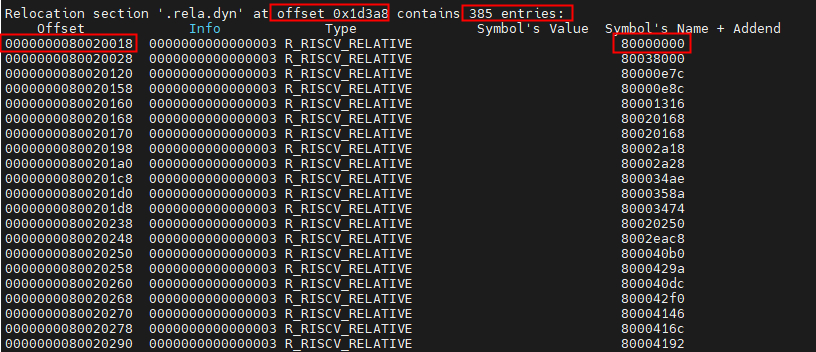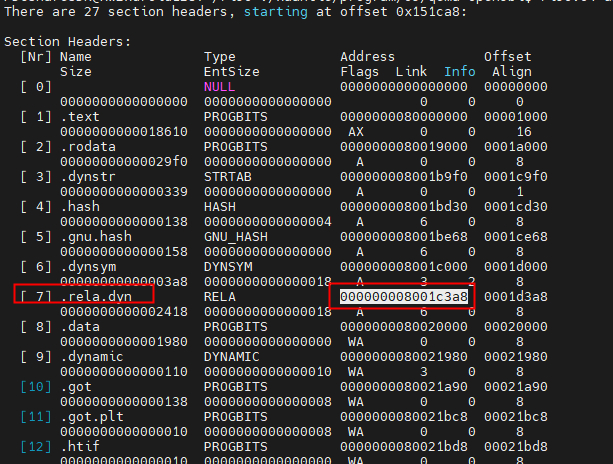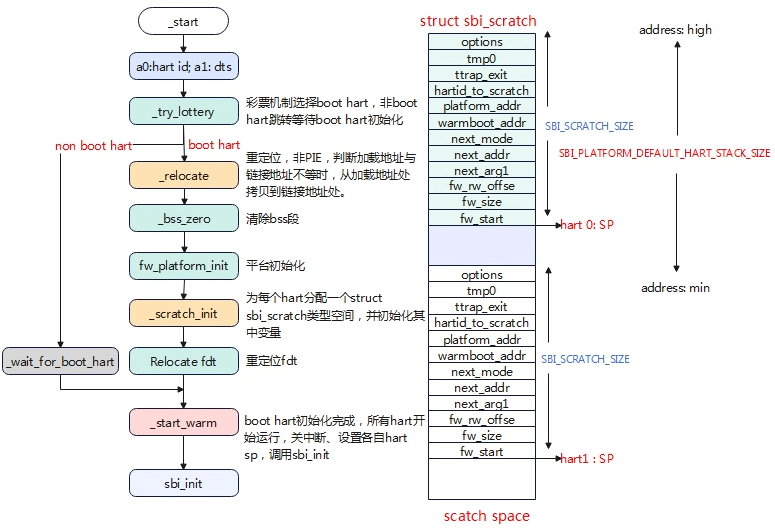opensbi分析(一)
引导Hart启动
_start:
/* Find preferred boot HART id */
MOV_3R s0, a0, s1, a1, s2, a2
# 将a0,a1,a2的参数分别赋值为s0,s1,s2,这3个参数是前一阶段传入的参数。
# a0: hart id
# a1: device tree
# a2: struct fw_dynamic_info地址
call fw_boot_hart
# fw_boot_hart会根据配置为fw_dynamic、fw_jump、fw_payload三种方式进行跳转,
# 后两种方式直接返回-1,即hart id使用随机的方式,而fw_dynamic根据传进来的参数
# 进行解析出boot hart id,a2指向struct fw_dynamic_info
# 我们这里分析使用的是fw_jump的方式。
add a6, a0, zero
# 将经过fw_boot_hart选择的hart id赋值为a6,这样a6保存的就是首先要启动的hart id
MOV_3R a0, s0, a1, s1, a2, s2
# 恢复a0,a1,a2的值,之前是暂存到s0,s1,s2中,因为前面调用了fw_boot_hart会修改
li a7, -1
beq a6, a7, _try_lottery
# 如果a6为-1,即上一阶段没有选定boot hard id,则使用彩票机制随机选择一个
# hard id进行先启动。
/* Jump to relocation wait loop if we are not boot hart */
bne a0, a6, _wait_relocate_copy_done
# 如果选择的boot hard id与当前运行的hart id不等,则进行等待boot hart id先运行。
_try_lottery:(彩票机制选择一个hart id作为启动hart)
/* Jump to relocation wait loop if we don't get relocation lottery */
lla a6, _relocate_lottery
# 加载_relocate_lottery(是一段bss空间)到a6寄存
li a7, 1
amoadd.w a6, a7, (a6)
# a6指向的地址上的值(_relocate_lottery 的地址)做原子加 1,
# _relocate_lottery 的老值写入a6(最原始的值为0)。
bnez a6, _wait_relocate_copy_done
# 如果a6不等于0,表示不是最先执行的hart,则跳转到_wait_relocate_copy_done
# 等待,如果等于0,表示最快运行的hart,则为boot hart往下走
# 与其说是彩票机制,看起来是赛跑机制,最先跑到这段代码的作为boot hart
上面的代码,主要是获取一个hart 作为boot hart,选定了boot hart后,其他的hart就需要等待boot hart先运行完成相关初始化工作再运行。如果opensbi使用的是fw_jump、fw_payload,选择boot hart的方式就是彩票机制。
重定位和初始化
预备信息
_fw_start
_fw_start的值,在链接脚本 build/platform/generic/firmware/fw_jump.elf.ld中指定

从通过工具链读取到_fw_start为0x80000000,如下:
.rela.dyn
.rela.dyn是重定位段,重定位是连接符号引用与符号定义的过程。例如,程序调用函数时,关联的调用指令必须在执行时将控制权转移到正确的目标地址。可重定位文件必须包含说明如何修改其节内容的信息。通过此信息,可执行文件和共享目标文件可包含进程的程序映像的正确信息。重定位项即是这些数据。
typedef struct elf32_rela{
Elf32_Addr r_offset;
Elf32_Word r_info;
Elf32_Sword r_addend;
} Elf32_Rela;
typedef struct elf64_rela {
Elf64_Addr r_offset; /* Location at which to apply the action */
Elf64_Xword r_info; /* index and type of relocation */
Elf64_Sxword r_addend; /* Constant addend used to compute value */
} Elf64_Rela;
重定位表的每个条目的内容如上数据结构所示,有3个变量。
- r_offset: 需要重定位地址的偏移,外部符号在got表的偏移
- r_r_info: 重定位的方法
- r_addend:重定位计算的值
使用 riscv64-unknown-linux-gnu-readelf -S build/platform/generic/firmware/fw_jump.elf命令可以看到重定位表的地址。
如上图.rela.dyn的地址为0x8001c3a8,长度为0x2418。
执行riscv64-unknown-linux-gnu-readelf -rW build/platform/generic/firmware/fw_jump.elf可以查看重定位信息表。

上图所示,fw_jump.elf的重定位表中有385个条目,即有385个地址需要重定位,上图中r_info是0x3,即类型是R_RISCV_RELATIVE,则重定位方式是按照B+A,B表示执行过程中将共享目标文件装入内存的基本地址,通常生成的共享目标文件的基本虚拟地址为0,在本节中B为_fw_start – FW_TEXT_START;A表示常量加数,用于计算存储在可重定位字段中的值,即r_addend的值,所以0x80020018的地址重定位到0x80000000。
怎么理解_fw_start 和 FW_TEXT_START地址?
- _fw_start表示加载地址
- FW_TEXT_START表示链接地址
在opensbi 1.2版本,_fw_start和FW_TEXT_START是一样的。
OpenSBI在什么时候引入的PIE支持?
在1.0版本引入的,https://github.com/riscv-software-src/opensbi/commit/0f20e8a?diff=split&w=0
- 链接脚本包含.rela.dyn节,该节中的所有重定位表项均是R_RISCV_RELATIVE类型。
- Self-relocataion发生在非常早期的汇编代码阶段firmware/fw_base.S
- 遍历.rela.dyn节里的所有重定位表项,进行地址修正
- 在重定位完成之前,所有对全局变量的地址引用,需要显式使用lla汇编伪指令(load local address)而不是la
- la在PIE模式下会编译成对GOT表的引用。
rela.dyn和.rel.dyn有什么区别?
.rel.dyn 和 .rela.dyn 都是 ELF 文件中用于存储重定位条目的节(section),它们主要用于动态链接过程中修正全局偏移表(GOT, Global Offset Table)和程序中的某些地址。不过,它们之间存在一些关键差异:
(1)数据结构不同:.rel.dyn 使用的是 REL 类型的重定位条目,每个条目包含两个字段:一个表示需要被重定位的位置的偏移量,另一个表示重定位类型。
.rela.dyn 使用的是 RELA 类型的重定位条目,在 REL 类型的基础上增加了一个 additive constant 字段,使得重定位操作可以直接应用一个立即数到目标位置,而不需要像 REL 那样进行间接计算。这意味着 RELA 类型提供了更直接的重定位能力。
(2)内存占用和效率:RELA 类型由于包含额外的 additive constant 字段,所以每个条目相比 REL 类型会占用更多的空间。然而,RELA 类型在处理时可能因为直接性而稍微提高效率,因为它减少了处理器需要执行的计算步骤。
(3)使用场景:在不同的系统或编译器配置下,可能会优先选择使用其中一种类型。通常,现代系统和编译器更倾向于使用 .rela.dyn,因为它虽然占用更多空间,但提供的直接重定位能力简化了链接过程。
总的来说,.rel.dyn 和 .rela.dyn 都服务于动态链接时的地址修正,主要区别在于重定位条目的格式及其对空间和处理效率的影响。在具体应用中,根据编译器选项和目标系统的偏好,会选择使用其中之一来完成动态链接所需的重定位工作。
/* Save load address */
lla t0, _load_start
# 加载地址存储到t0寄存器:0x0000000080020018
lla t1, _fw_start
# _fw_start存储到t1寄存器:t1片=0x0000000080000000
# _fw_start为链接脚本中设定的起始地址
REG_S t1, 0(t0)
# REG_S是sd,即t1的值存储到t0的地址
# 可以理解为_load_start是一个全局指针(指向事先分配的空间),将fw_jump.elf
# 的起始地址即,在链接脚本中设置的赋值_load_start中存储。
#ifdef FW_PIC
/* relocate the global table content */
lla t0, _link_start
# _link_start存储到t0寄存器:t0 = 0x0000000080020020
REG_L t0, 0(t0)
# 将t0地址的值加载到t0,t0=0x0000000080000000,
# _link_start指向一个dword全局变量的指针,指向的是FW_TEXT_START
# 在firmware/fw_base.S中如下定义
# _link_start:gg
# RISCV_PTR FW_TEXT_START
# 所以上面代码的意思就是将FW_TEXT_START赋值为t0,FW_TEXT_START在
# platform/generic/objects.mk中定义,表示FW TEXT段的开始地址
# 正好也是FW_TEXT_START=0x80000000
# FW_TEXT_START设置的是固件要运行的起始地址,而_fw_start是链接地址
/* t1 shall has the address of _fw_start */
sub t2, t1, t0
# t2 = _fw_start - FW_TEXT_START,计算要运行地址和链接地址的差值
lla t3, _runtime_offset
# t3 = 0x0000000080020060,申请的一个全局变量(bss空间)
REG_S t2, (t3)
# 将运行的地址与链接地址的偏移存储到_runtime_offset指向的地址中
lla t0, __rel_dyn_start
# 重定位表开始地址:0x000000008001c3a8
lla t1, __rel_dyn_end
# 重定位表的结束地址:0x000000008001e7c0
# 结束地址减去起始地址正好size为0x2418,跟前面章节对应。
beq t0, t1, _relocate_done
j 5f
# 如果重定位表的开始地址等于结束地址,说明不需要重定位,直接跳转到
# _relocate_done结束重定位,否则跳转到5标签进行重定位。
2:
REG_L t5, -(REGBYTES*2)(t0) /* t5 <-- relocation info:type */
# REG_L为ld,t0-16地址指向条目的第二个成员变量即info type
li t3, R_RISCV_RELATIVE /* reloc type R_RISCV_RELATIVE */
bne t5, t3, 3f
# 如果info type不是R_RISCV_RELATIVE类型,则跳转到标签
# 接下来就是处理info type为R_RISCV_RELATIVE的重定位
REG_L t3, -(REGBYTES*3)(t0)
# 获取重定位表一个条目中offset的值存储到t3
REG_L t5, -(REGBYTES)(t0) /* t5 <-- addend */
# 获取重定位表一个条目中addend值
add t5, t5, t2
# 即重定位地址为B+A,A为addend值,B=_fw_start - FW_TEXT_START
add t3, t3, t2
REG_S t5, 0(t3) /* store runtime address to the GOT entry */
# 将重定位的地址更新到GOT表中去。
j 5f
# 跳转到标签5继续循环,将所有的重定位条目更新到GOT表中去。
# 标签3和4是针对info type不是R_RISCV_RELATIVE的处理,这里就不再分析了。
3:
lla t4, __dyn_sym_start
4:
REG_L t5, -(REGBYTES*2)(t0) /* t5 <-- relocation info:type */
srli t6, t5, SYM_INDEX /* t6 <--- sym table index */
andi t5, t5, 0xFF /* t5 <--- relocation type */
li t3, RELOC_TYPE
bne t5, t3, 5f
/* address R_RISCV_64 or R_RISCV_32 cases*/
REG_L t3, -(REGBYTES*3)(t0)
li t5, SYM_SIZE
mul t6, t6, t5
add s5, t4, t6
REG_L t6, -(REGBYTES)(t0) /* t0 <-- addend */
REG_L t5, REGBYTES(s5)
add t5, t5, t6
add t5, t5, t2 /* t5 <-- location to fix up in RAM */
add t3, t3, t2 /* t3 <-- location to fix up in RAM */
REG_S t5, 0(t3) /* store runtime address to the variable */
5:
addi t0, t0, (REGBYTES*3)
# REGBYTES在64位系统为8字节大小,__rel_dyn_start偏移3个变量,即24字节大小
# 正好就是一个条目的大小(Elf64_Rela数据结构)。
ble t0, t1, 2b
# 如果t0加了一个条目的大小还小于__rel_dyn_end则跳转到2标签。
j _relocate_done
_wait_relocate_copy_done:
j _wait_for_boot_hart
_relocate_done:
/*
* Mark relocate copy done
* Use _boot_status copy relative to the load address
*/
lla t0, _boot_status
# t0 = 0x0000000080020010
#ifndef FW_PIC
lla t1, _link_start
REG_L t1, 0(t1)
lla t2, _load_start
REG_L t2, 0(t2)
sub t0, t0, t1
add t0, t0, t2
#endif
li t1, BOOT_STATUS_RELOCATE_DONE
# t1 = 1
REG_S t1, 0(t0)
# 将1 写到_boot_status指向的地址
fence rw, rw
# 建立一个全局内存屏障,确保该指令执行前后,所有写操作都完成完成。
# _relocate_done的作用就是写一个标志位到_boot_status表示重定位
# 已经完成。
状态初始化
/* At this point we are running from link address */
/* Reset all registers for boot HART */
li ra, 0
call _reset_regs
# 清除所有的寄存器
/* Zero-out BSS */
lla s4, _bss_start
lla s5, _bss_end
_bss_zero:
REG_S zero, (s4)
add s4, s4, __SIZEOF_POINTER__
blt s4, s5, _bss_zero
# 清除BSS段,BSS段写0
/* Setup temporary trap handler */
lla s4, _start_hang
csrw CSR_MTVEC, s4
# 设置临时的trap handle,里面直接进入WFI
/* Setup temporary stack */
lla s4, _fw_end
li s5, (SBI_SCRATCH_SIZE * 2)
add sp, s4, s5
# 设置临时栈
/* Allow main firmware to save info */
MOV_5R s0, a0, s1, a1, s2, a2, s3, a3, s4, a4
call fw_save_info
MOV_5R a0, s0, a1, s1, a2, s2, a3, s3, a4, s4
初始化平台
/*
* Initialize platform
* Note: The a0 to a4 registers passed to the
* firmware are parameters to this function.
*/
MOV_5R s0, a0, s1, a1, s2, a2, s3, a3, s4, a4
call fw_platform_init
add t0, a0, zero
MOV_5R a0, s0, a1, s1, a2, s2, a3, s3, a4, s4
add a1, t0, zero
struct sbi_platform {
/**
* OpenSBI version this sbi_platform is based on.
* It's a 32-bit value where upper 16-bits are major number
* and lower 16-bits are minor number
*/
u32 opensbi_version;
/**
* OpenSBI platform version released by vendor.
* It's a 32-bit value where upper 16-bits are major number
* and lower 16-bits are minor number
*/
u32 platform_version;
/** Name of the platform */
char name[64];
/** Supported features */
u64 features;
/** Total number of HARTs */
u32 hart_count;
/** Per-HART stack size for exception/interrupt handling */
u32 hart_stack_size;
/** Pointer to sbi platform operations */
unsigned long platform_ops_addr;
/** Pointer to system firmware specific context */
unsigned long firmware_context;
/**
* HART index to HART id table
*
* For used HART index <abc>:
* hart_index2id[<abc>] = some HART id
* For unused HART index <abc>:
* hart_index2id[<abc>] = -1U
*
* If hart_index2id == NULL then we assume identity mapping
* hart_index2id[<abc>] = <abc>
*
* We have only two restrictions:
* 1. HART index < sbi_platform hart_count
* 2. HART id < SBI_HARTMASK_MAX_BITS
*/
const u32 *hart_index2id;
};
struct sbi_platform platform = {
.opensbi_version = OPENSBI_VERSION,
.platform_version =
SBI_PLATFORM_VERSION(CONFIG_PLATFORM_GENERIC_MAJOR_VER,
CONFIG_PLATFORM_GENERIC_MINOR_VER),
.name = CONFIG_PLATFORM_GENERIC_NAME,
.features = SBI_PLATFORM_DEFAULT_FEATURES,
.hart_count = SBI_HARTMASK_MAX_BITS,
.hart_index2id = generic_hart_index2id,
.hart_stack_size = SBI_PLATFORM_DEFAULT_HART_STACK_SIZE,
.platform_ops_addr = (unsigned long)&platform_ops
};
初始化sbi_scratch
/** Representation of per-HART scratch space */
struct sbi_scratch {
/** Start (or base) address of firmware linked to OpenSBI library */
unsigned long fw_start;
/** Size (in bytes) of firmware linked to OpenSBI library */
unsigned long fw_size;
/** Offset (in bytes) of the R/W section */
unsigned long fw_rw_offset;
/** Arg1 (or 'a1' register) of next booting stage for this HART */
unsigned long next_arg1;
/** Address of next booting stage for this HART */
unsigned long next_addr;
/** Privilege mode of next booting stage for this HART */
unsigned long next_mode;
/** Warm boot entry point address for this HART */
unsigned long warmboot_addr;
/** Address of sbi_platform */
unsigned long platform_addr;
/** Address of HART ID to sbi_scratch conversion function */
unsigned long hartid_to_scratch;
/** Address of trap exit function */
unsigned long trap_exit;
/** Temporary storage */
unsigned long tmp0;
/** Options for OpenSBI library */
unsigned long options;
};
接下来的代码就是创建一段空间,给sbi_scratch,然后将里面的值填充。
/* Preload HART details
* s7 -> HART Count
* s8 -> HART Stack Size
*/
lla a4, platform
# 加载platform的地址到a4寄存器
#if __riscv_xlen > 32
lwu s7, SBI_PLATFORM_HART_COUNT_OFFSET(a4)
lwu s8, SBI_PLATFORM_HART_STACK_SIZE_OFFSET(a4)
#else
lw s7, SBI_PLATFORM_HART_COUNT_OFFSET(a4)
# 基于a4地址偏移80字节,即指向platform->hart_count:1?为啥不是128?
lw s8, SBI_PLATFORM_HART_STACK_SIZE_OFFSET(a4)
# 基于a4地址偏移84字节,即指向platform->hart_stack_size:8192
#endif
/* Setup scratch space for all the HARTs*/
lla tp, _fw_end
# 加载_fw_end: 0x80038000
mul a5, s7, s8
# a5 = s7 *s8 = 1 * 0x2000 = 0x2000
add tp, tp, a5
# tp = tp +a5 = 0x80038000 + 0x2000 = 0x8003a000
/* Keep a copy of tp */
add t3, tp, zero
# t3 = tp = 0x8003a000
/* Counter */
li t2, 1
/* hartid 0 is mandated by ISA */
li t1, 0
# tp 是 RISC-V 中的一个特殊寄存器,用于指向临时工作区域(scratch space)。
# 将 _fw_end 地址加载进 tp, 在用 s7,s8 计算出 scratch space, 再加上 tp,
# 这样就相当于分配了一段hart的暂存空间。
_scratch_init:
/*
* The following registers hold values that are computed before
* entering this block, and should remain unchanged.
*
* t3 -> the firmware end address
* s7 -> HART count
* s8 -> HART stack size
*/
add tp, t3, zero
# tp = t3 = 0x8003a000
mul a5, s8, t1
# a5 = s8 *s1 = 0
sub tp, tp, a5
# tp = tp - a5 = 0x8003a000
li a5, SBI_SCRATCH_SIZE
# 加载SBI_SRATCH_SIZE空间到a5,这里是0x1000
sub tp, tp, a5
# tp = tp - a5 = 0x80039000
/* Initialize scratch space */
/* Store fw_start and fw_size in scratch space */
lla a4, _fw_start
sub a5, t3, a4
REG_S a4, SBI_SCRATCH_FW_START_OFFSET(tp)
REG_S a5, SBI_SCRATCH_FW_SIZE_OFFSET(tp)
# 将fw_start和fw_size写到scratch空间
/* Store R/W section's offset in scratch space */
lla a4, __fw_rw_offset
REG_L a5, 0(a4)
REG_S a5, SBI_SCRATCH_FW_RW_OFFSET(tp)
# 将__fw_rw_offset= _fw_rw_start - _fw_start,写到scratch空间。
# 即data段的偏移位置。
/* Store next arg1 in scratch space */
MOV_3R s0, a0, s1, a1, s2, a2
call fw_next_arg1
REG_S a0, SBI_SCRATCH_NEXT_ARG1_OFFSET(tp)
MOV_3R a0, s0, a1, s1, a2, s2
# 存储下一阶段启动的传递的第一个参数,这里是FW_JUMP_FDT_ADDR
# 在platform/generic/objects.mk中配置,= ($(FW_TEXT_START) + 0x2200000))
# FW_JUMP_FDT_ADDR = 0x82200000
/* Store next address in scratch space */
MOV_3R s0, a0, s1, a1, s2, a2
call fw_next_addr
REG_S a0, SBI_SCRATCH_NEXT_ADDR_OFFSET(tp)
MOV_3R a0, s0, a1, s1, a2, s2
# 存储下一阶段启动地址,即opensbi运行阶段要跳转的地址
# 跳转的地址为FW_JUMP_ADDR,object.mk中设置
# = ($(FW_TEXT_START) + 0x200000))
# 所以FW_JUMP_ADDR = 0x80200000
/* Store next mode in scratch space */
MOV_3R s0, a0, s1, a1, s2, a2
call fw_next_mode
REG_S a0, SBI_SCRATCH_NEXT_MODE_OFFSET(tp)
MOV_3R a0, s0, a1, s1, a2, s2
# 将下一阶段启动的模式存储next_mode,这里是S模式:1
/* Store warm_boot address in scratch space */
lla a4, _start_warm
REG_S a4, SBI_SCRATCH_WARMBOOT_ADDR_OFFSET(tp)
# 存储warm_boot启动地址:0x80000354
# 即:firmware/fw_base.S::426行
/* Store platform address in scratch space */
lla a4, platform
REG_S a4, SBI_SCRATCH_PLATFORM_ADDR_OFFSET(tp)
# 存储platform的地址
/* Store hartid-to-scratch function address in scratch space */
lla a4, _hartid_to_scratch
REG_S a4, SBI_SCRATCH_HARTID_TO_SCRATCH_OFFSET(tp)
# 存储_hartid_to_scratch地址,这段是其他hard调用该函数用于分配scratch空间
/* Store trap-exit function address in scratch space */
lla a4, _trap_exit
REG_S a4, SBI_SCRATCH_TRAP_EXIT_OFFSET(tp)
# 存储的是trap退出函数
/* Clear tmp0 in scratch space */
REG_S zero, SBI_SCRATCH_TMP0_OFFSET(tp)
/* Store firmware options in scratch space */
MOV_3R s0, a0, s1, a1, s2, a2
#ifdef FW_OPTIONS
li a0, FW_OPTIONS
#else
call fw_options
#endif
REG_S a0, SBI_SCRATCH_OPTIONS_OFFSET(tp)
MOV_3R a0, s0, a1, s1, a2, s2
/* Move to next scratch space */
add t1, t1, t2
blt t1, s7, _scratch_init
# 完成一个hart的scrach初始化,接着为下一个hart分配一个scratch并初始化。
FDT重定位
/*
* Relocate Flatened Device Tree (FDT)
* source FDT address = previous arg1
* destination FDT address = next arg1
*
* Note: We will preserve a0 and a1 passed by
* previous booting stage.
*/
beqz a1, _fdt_reloc_done
/* Mask values in a4 */
li a4, 0xff
/* t1 = destination FDT start address */
MOV_3R s0, a0, s1, a1, s2, a2
call fw_next_arg1
add t1, a0, zero
MOV_3R a0, s0, a1, s1, a2, s2
beqz t1, _fdt_reloc_done
beq t1, a1, _fdt_reloc_done
/* t0 = source FDT start address */
add t0, a1, zero
/* t2 = source FDT size in big-endian */
#if __riscv_xlen == 64
lwu t2, 4(t0)
#else
lw t2, 4(t0)
#endif
/* t3 = bit[15:8] of FDT size */
add t3, t2, zero
srli t3, t3, 16
and t3, t3, a4
slli t3, t3, 8
/* t4 = bit[23:16] of FDT size */
add t4, t2, zero
srli t4, t4, 8
and t4, t4, a4
slli t4, t4, 16
/* t5 = bit[31:24] of FDT size */
add t5, t2, zero
and t5, t5, a4
slli t5, t5, 24
/* t2 = bit[7:0] of FDT size */
srli t2, t2, 24
and t2, t2, a4
/* t2 = FDT size in little-endian */
or t2, t2, t3
or t2, t2, t4
or t2, t2, t5
/* t2 = destination FDT end address */
add t2, t1, t2
/* FDT copy loop */
ble t2, t1, _fdt_reloc_done
_fdt_reloc_again:
REG_L t3, 0(t0)
REG_S t3, 0(t1)
add t0, t0, __SIZEOF_POINTER__
add t1, t1, __SIZEOF_POINTER__
blt t1, t2, _fdt_reloc_again
boot hard启动完成
_fdt_reloc_done:
/* mark boot hart done */
li t0, BOOT_STATUS_BOOT_HART_DONE
lla t1, _boot_status
REG_S t0, 0(t1)
fence rw, rw
j _start_warm
# boot hart启动完成,写入一个标志位,以便通知其他hart,跳转到热启动
非boot hart等待运行
/* waiting for boot hart to be done (_boot_status == 2) */
_wait_for_boot_hart:
li t0, BOOT_STATUS_BOOT_HART_DONE
lla t1, _boot_status
REG_L t1, 0(t1)
/* Reduce the bus traffic so that boot hart may proceed faster */
nop
nop
nop
bne t0, t1, _wait_for_boot_hart
# 读取_boot_status的标志,判断boot hart是否运行初始化完,如果初始化
# 即可进入_start_warm,否则需要一直等待。
hart 热启动
_start_warm:
/* Reset all registers for non-boot HARTs */
li ra, 0
call _reset_regs
# 对于non-boot HARTS复位寄存器
/* Disable all interrupts */
csrw CSR_MIE, zero
# 关闭所有的中断
/* Find HART count and HART stack size */
lla a4, platform
#if __riscv_xlen == 64
lwu s7, SBI_PLATFORM_HART_COUNT_OFFSET(a4)
lwu s8, SBI_PLATFORM_HART_STACK_SIZE_OFFSET(a4)
#else
lw s7, SBI_PLATFORM_HART_COUNT_OFFSET(a4)
lw s8, SBI_PLATFORM_HART_STACK_SIZE_OFFSET(a4)
#endif
REG_L s9, SBI_PLATFORM_HART_INDEX2ID_OFFSET(a4)
# 加载platform,获取到Hart count和hart stack size
/* Find HART id */
csrr s6, CSR_MHARTID
# 获取当前的hart id
/* Find HART index */
beqz s9, 3f
li a4, 0
1:
#if __riscv_xlen == 64
lwu a5, (s9)
#else
lw a5, (s9)
#endif
beq a5, s6, 2f
add s9, s9, 4
add a4, a4, 1
blt a4, s7, 1b
li a4, -1
2: add s6, a4, zero
3: bge s6, s7, _start_hang
/* Find the scratch space based on HART index */
lla tp, _fw_end
mul a5, s7, s8
add tp, tp, a5
mul a5, s8, s6
sub tp, tp, a5
li a5, SBI_SCRATCH_SIZE
sub tp, tp, a5
# 根据hart index找到对应的scratch space
/* update the mscratch */
csrw CSR_MSCRATCH, tp
# 将scratch地址更新到mscratch寄存器中
/* Setup stack */
add sp, tp, zero
# 设置hart的栈空间
/* Setup trap handler */
lla a4, _trap_handler
#if __riscv_xlen == 32
csrr a5, CSR_MISA
srli a5, a5, ('H' - 'A')
andi a5, a5, 0x1
beq a5, zero, _skip_trap_handler_rv32_hyp
lla a4, _trap_handler_rv32_hyp
_skip_trap_handler_rv32_hyp:
#endif
csrw CSR_MTVEC, a4
# 设置trap处理入口函数_trap_handler
#if __riscv_xlen == 32
/* Override trap exit for H-extension */
csrr a5, CSR_MISA
srli a5, a5, ('H' - 'A')
andi a5, a5, 0x1
beq a5, zero, _skip_trap_exit_rv32_hyp
lla a4, _trap_exit_rv32_hyp
csrr a5, CSR_MSCRATCH
REG_S a4, SBI_SCRATCH_TRAP_EXIT_OFFSET(a5)
_skip_trap_exit_rv32_hyp:
#endif
/* Initialize SBI runtime */
csrr a0, CSR_MSCRATCH
call sbi_init
# scratch的地址作为参数,跳转到sbi_init执行。
小结
本文参考:
[泰晓科技OpenSBI分析1](https://tinylab.org/sbi-firmware-analyze-41/ \”泰晓科技OpenSBI分析1\”)
[泰晓科技OpenSBI分析2](https://tinylab.org/sbi-firmware-analyze-2/ \”泰晓科技OpenSBI分析2\”)
[泰晓科技OpenSBI分析3](https://tinylab.org/sbi-firmware-analyze-3/ \”泰晓科技OpenSBI分析3\”)
[泰晓科技OpenSBI分析4](https://tinylab.org/sbi-firmware-analyze-4/ \”泰晓科技OpenSBI分析4\”)
[passenger12234的博客 OpenSBI分析](https://blog.csdn.net/passenger12234/category_11411139.html \”passenger12234的博客 OpenSBI分析\”)
[OpenSBI ELF rela.dyn和.dynsym动态链接过程](https://blog.csdn.net/dai_xiangjun/article/details/123629743 \”OpenSBI ELF rela.dyn和.dynsym动态链接过程\”)



